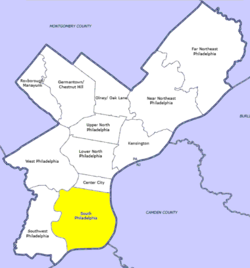South Philly
| South Philadelphia | |
|---|---|
| Neighborhood of Philadelphia | |

Gloria Dei (Old Swedes') Church, Queen Village, South Philadelphia
|
|
 South Philadelphia district, highlighted on a map of Philadelphia County |
|
| Coordinates: 39°55′23″N 75°10′31″W / 39.9231°N 75.1753°WCoordinates: 39°55′23″N 75°10′31″W / 39.9231°N 75.1753°W | |
| Country | |
| State |
|
| County |
|
| City |
|
| Area | |
| • Total | 9.7 sq mi (25 km2) |
| Population (2010) | |
| • Total | 168,782 |
| • Density | 17,000/sq mi (6,700/km2) |
| ZIP code | 19145, 19146, 19147, 19148 |
| Area code(s) | 267, 215 |
South Philadelphia, nicknamed South Philly, is the section of Philadelphia bounded by South Street to the north, the Delaware River to the east and south, and the Schuylkill River to the west. A diverse community, South Philadelphia is known for its large Italian American population. South Philadelphia also contains large Irish American and African American populations as well.
South Philadelphia began as a satellite town of Philadelphia, with small townships such as Moyamensing and Southwark. Towards the end of the Industrial Revolution, the area saw rapid growth in population and urban development. This expansion was in part due to an influx of working class laborers and immigrants looking for factory jobs and dock work, as well as the first wave of mass immigration of refugees and impoverished immigrants from Ireland in the wake of the Great Irish Hunger. South Philadelphia's urbanized border eventually expanded to reach that of Philadelphia proper, or what is today known as Center City Philadelphia. Along with all other jurisdictions in Philadelphia County, South Philadelphia became part of the City of Philadelphia proper with passage by the Pennsylvania legislature of the city/county Act of Consolidation, 1854.
The area continued to grow, becoming a vital part of Philadelphia's large industrial base and attracting immigrants from Italy, Ireland, Poland, and many Southern European and Eastern European countries during the late 19th and early 20th centuries, as well as Black American migrants from the southern United States during the Great Migration of the early 20th century. The immigrants and migrants became the basis of South Philadelphia's unique and vibrant culture that developed over the next several decades. Struggling to maintain their Catholic identity in a mostly Protestant city, the Irish built a system of Irish Catholic churches and parochial schools for their children, including Catholic high schools. The later immigrant populations of Italians and Poles were also Catholic. Initially, these populations attended existing Catholic churches but built their own ethno-national churches when possible. However, the more established Irish-American ethnic community controlled the Catholic clergy and hierarchy for decades in Philadelphia and throughout the region, often excluding the more recent Italian (and, to a lesser extent, Polish) populations from participating in the church hierarchy. In addition to the influx of Catholic immigrants, many Polish Jews and other Jews from Eastern Europe settled in South Philadelphia during the first half of the 20th century, especially in the diverse area now known as Queen Village where Jewish immigrants lived among Catholic Polish immigrants, Irish-Americans, and Italian immigrants. A smaller but significant Greek immigrant community also flourished around this time, leading to the establishment of Greek Orthodox parishes in South Philadelphia. Despite this dramatic growth in population, the low funding of education by the city resulted in the first public high school not being formed in South Philadelphia until 1934.
...
Wikipedia
